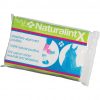A sub-solar hoof abscess, also known as pus in the foot is a common cause of lameness, particularly in wet weather conditions following a long dry period, as well as during an extended spell of frequent and heavy rain. It is thought that tiny cracks appear in the hoof wall and allow moisture, dirt and bacteria to enter. Infection sets in, followed by a build-up of pus that, within the restricting hoof cavity, soon becomes extremely painful. Other cases are associated with puncture wounds to the hoof, while sometimes infection can ascend via the openings left by the tracts of horseshoe nails.
It is not unusual for an abscess to cause a horse to be non-weight bearing on the affected limb, and many a vet has been called to a horse with a “broken leg” that turns out to be an abscess. If you suspect your horse may be suffering from an infection in the hoof, a visit from your vet or farrier should be arranged as soon as possible as relieving the horse’s discomfort must be a priority.
Hoof abscess in horses: Signs | Treatment | Complications
How to recognise a hoof abscess
- Be vigilant of any slight or intermittent lameness that becomes more pronounced until the horse almost bears no weight on the affected leg
- More weight may be carried on the toe to protect the heel
- The affected foot may feel hotter than the other feet
- There may be a noticeable or pounding digital pulse towards the back of either side of the fetlock
- The leg may become filled and swollen
- There may be severe pain and signs of distress
- If not drained, the abscess will eventually burst through the coronary band
How to treat a hoof abscess
It is likely that the shoe will need to be removed to find the hoof abscess, which, once located and drained, will bring rapid relief.
The farrier or vet will advise how to clean the site, perhaps with antiseptic or hydrogen peroxide. Traditionally, tubbing the foot in warm salty water has been recommended, however this can soften the hoof wall and sole, which may not be in the horse’s best interests.
Typically a hot wet poultice is applied to the hard horn on the sole of the hoof, being replaced twice a day for for up to three days, to encourage the abscess to drain downwards. This avoids the need to poultice the soft skin of the coronary band. It is not recommended to use a wet poultice for more than three days.
The area should be kept covered until it has healed sufficiently to prevent any dirt from entering the wound. Disposable nappies make very effective dressings for this purpose.

How to poultice a horse’s hoof: your essential guide
Dr Stuart Thorne MRCVS, of Fellowes Farm Equine Clinic, gives useful tips to make poulticing easy
While many vets and farriers will recommend stabling the horse during treatment to reduce the risk of further infection from external debris while the wound is open, some owners continue to turn their horses out while protecting the dressing with a thick plastic bag secured with thick strong tape. If you do so, take care not to cause a pressure sore when taping over the hoof covering.
It is usually unnecessary to treat pus in the foot with antibiotics. It is better to drain the abscess to eliminate the infection, particularly since antibiotics do not penetrate properly into the hoof and horn of the horse’s foot. Antibiotics are only really justifiable in rare cases where there are complications and the deeper structures within the foot are involved.
It is far more important to establish adequate drainage to ensure all the infection can drain while giving the horse sufficient pain relief. The two are frequently combined in that a horse with a foot abscess will feel much better as soon as the pus is drained.
Once located and drained, most abscesses will resolve in a week or two with one study showing that they take an average of 11 days of treatment.
Complications
Most foot abscesses are straightforward and can be treated relatively rapidly, however complications can develop. These include cellulitis (infection in the soft tissues), hoof cracks, inflammation and infection of the underlying pedal bone and other structures, as well as recurrent abscesses. If a horse suffers repeatedly from hoof abscesses then it may be worth testing for Cushings/PPID as this can be a sign of that condition.
Fortunately the majority of cases recover well, and once the pus in the foot has drained, then the horse’s shoe can be refitted and they can return to work.
References:
Factors associated with prolonged treatment days, increased veterinary visits and complications in horses with subsolar abscesses – December 2018
Foot abscessation in horses – February 2019
Horse & Hound magazine, out every Thursday, is packed with all the latest news and reports, as well as interviews, specials, nostalgia, vet and training advice. Find how you can enjoy the magazine delivered to your door every week, plus options to upgrade your subscription to access our online service that brings you breaking news and reports as well as other benefits.



